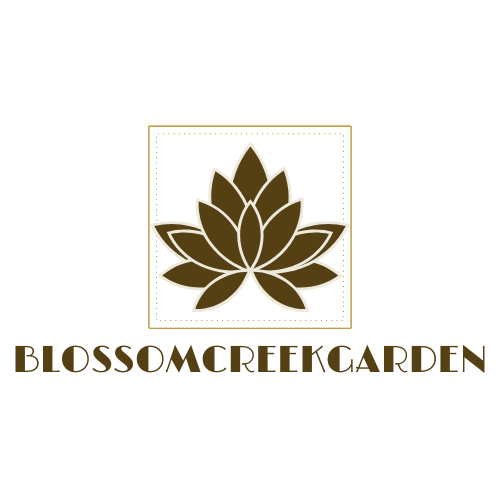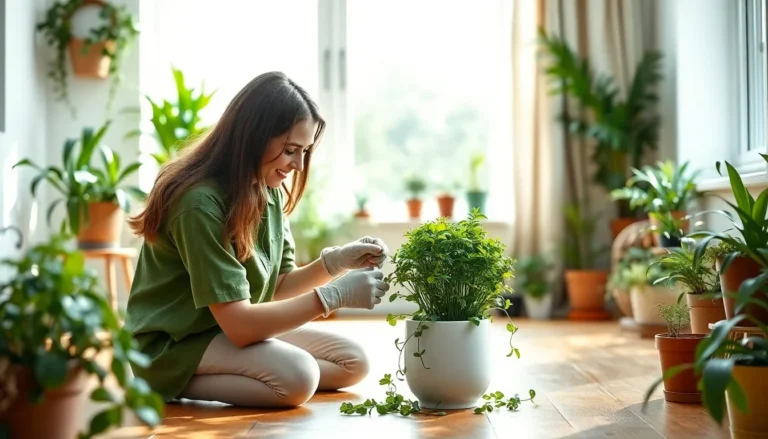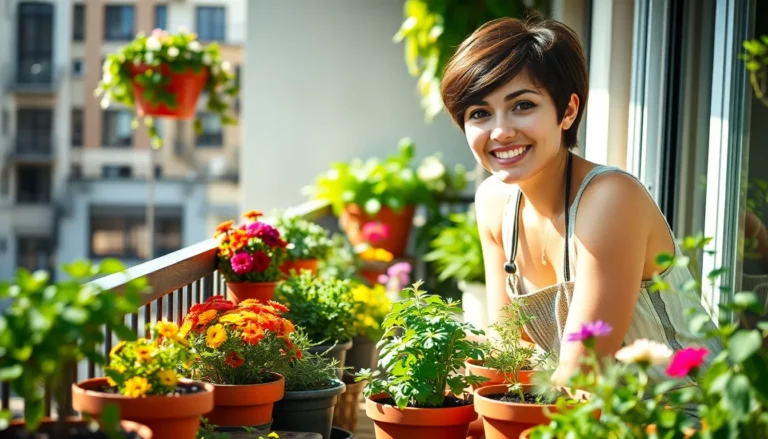Gardening can be a delightful escape, but it often comes with its share of aches and pains. Enter the kneeling pad—a gardener’s best friend that turns an uncomfortable task into a cozy adventure. Imagine sinking into a plush cloud while you dig up weeds or plant your favorite flowers. Sounds dreamy, right?
Kneeling Pad For Gardening
Using a kneeling pad in gardening significantly enhances comfort and support while reducing the strain associated with gardening tasks. Gardeners experience an enjoyable and functional improvement when utilizing this simple tool.
Comfort And Support
Comfort comes first with a kneeling pad. Soft cushioning alleviates pressure on knees during activities like planting and weeding. Such padding allows users to kneel for extended periods without discomfort. Supportive materials reduce fatigue, making gardening longer easier. The benefits extend beyond comfort, as many pads feature handles for easy transport. Mobility enhances the overall gardening experience by allowing users to move quickly between tasks.
Injury Prevention
Injury prevention plays a critical role in gardening. Kneeling pads offer a protective barrier against hard surfaces, minimizing the risk of joint injuries. Cushioned support reduces impact while kneeling. Many users find they can garden without experiencing pain, promoting a more sustainable practice. Additionally, proper body alignment is maintained when using a pad, ensuring better posture while working. The prevention of strain-related injuries leads to longer-term enjoyment of gardening activities.
Features To Look For In A Kneeling Pad

Choosing the right kneeling pad involves specific features that enhance comfort and durability. Key factors include material quality, thickness, and size, all of which contribute to a positive gardening experience.
Material Quality
Selecting a kneeling pad with high-quality materials ensures longevity and comfort. Foam densities vary, impacting overall support and cushioning. Look for pads made from durable, waterproof materials, as they resist wear and moisture. Common options include memory foam and gel, both providing excellent support and preventing sinking. Non-slip surfaces enhance stability while kneeling, preventing accidental slips during use. Additionally, easy-to-clean materials save time and effort, keeping the pad in good condition for years.
Thickness And Size
The thickness of a kneeling pad significantly affects comfort during gardening tasks. A thicker pad often offers better cushioning and support, allowing for prolonged use without discomfort. Standard thickness ranges from 0.5 to 2 inches, where thicker options provide extra comfort on hard surfaces. Size also matters, as a larger pad offers ample space for movement and stability. Dimensions typically range from 18 to 24 inches in length and 12 to 16 inches in width, accommodating various gardening positions. Choosing the right size allows gardeners to kneel freely and comfortably, enhancing the overall gardening experience.
Reviews Of Popular Kneeling Pads For Gardening
Several options exist for gardeners seeking comfort and support. Each kneeling pad offers unique features tailored to various needs.
Top Brands
Gardener’s Supply Company stands out with its durable and waterproof kneeling pads. This brand uses high-quality materials, ensuring long-lasting use. The ProGarden kneeling pad is another great option known for its excellent foam density. Its lightweight design allows for easy transport. Lastly, the Tomita kneeling pad features a non-slip surface, providing stability during gardening tasks. These brands consistently prioritize user comfort and durability.
Customer Feedback
Many users praise the soft cushioning in these kneeling pads. Feedback often highlights how they alleviate knee strain, allowing for extended gardening sessions. Some customers prefer thicker options, noting they provide superior cushioning on hard surfaces. Users frequently mention the convenience of easy-to-clean materials, which help the pads maintain their condition. Overall, gardeners appreciate the added stability and comfort of these kneeling pads, enhancing their overall gardening experience.
Maintenance And Care Tips
Regular care enhances the lifespan of a kneeling pad for gardening. Following a few simple maintenance tips keeps it in optimal condition.
Cleaning Instructions
Cleaning a kneeling pad requires minimal effort. Use a mild soap solution and a soft cloth to wipe down the surface. Rinse with water to remove soap residue, ensuring no cleaning agents remain. For stubborn stains, consider using a gentle scrub brush. Air drying is best; avoid direct sunlight to prevent material degradation. Regularly cleaning the pad helps maintain hygiene, especially after use on dirty garden surfaces.
Storage Recommendations
Storing a kneeling pad properly prolongs its life. Avoid putting heavy objects on top, which can cause deformation. Choose a cool, dry area for storage, protecting it from extreme temperatures. Rolling the pad tightly is an effective approach; this minimizes creasing and maintains its shape. Keep it in a designated gardening area or a shed for easy access. Proper storage practices keep the pad looking new and ready for use whenever gardening activities arise.
Conclusion
Investing in a kneeling pad can truly enhance the gardening experience. By providing essential comfort and support it allows gardeners to focus on their tasks without the distraction of discomfort. The right kneeling pad not only protects the knees but also promotes better posture and reduces fatigue during long gardening sessions.
With various options available on the market choosing a high-quality kneeling pad tailored to individual needs can make all the difference. Proper maintenance ensures longevity allowing gardeners to enjoy their time outdoors without the worry of wear and tear. Ultimately a kneeling pad is an indispensable tool for anyone looking to cultivate their garden with ease and enjoyment.




